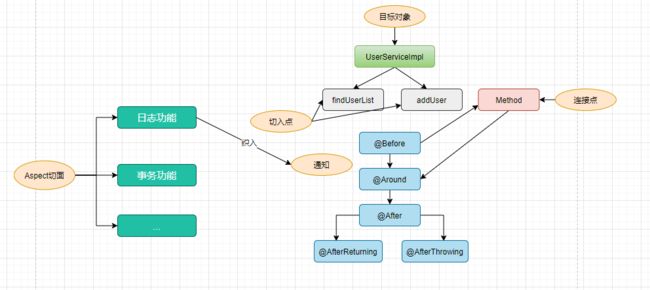spring底层之AOP面向切面编程原理及配置使用
概述
AOP是什么
AOP为Aspect Oriented Programming的缩写,意为:面向切面编程
AOP最早是由AOP联盟的组织提出的,指定的一套规范,spring将AOP的思想引入框架之中,通过预编译方式和运行期间动态代理实现程序的统一维护的一种技术
引例中关于给service添加日志的方法著作权归https://pdai.tech所有。
public class UserServiceImpl implements IUserService {
/**
* find user list.
*
* @return user list
*/
@Override
public List<User> findUserList() {
System.out.println("execute method: findUserList");
return Collections.singletonList(new User("pdai", 18));
}
/**
* add user
*/
@Override
public void addUser() {
System.out.println("execute method: addUser");
// do something
}
}
要给一个service的每一个方法都添加日志功能,传统的做法就是在每一个方法中,加入日志功能。
引入AOP后,我们将日志功能解耦成日志切面。将日志功能横向的切割为一个独立的模块

- 在OOP面向对象的思想中,我们是针对业务的处理过程当中的属性(字段)以及行为(方法)进行抽象封装,封装的结果就是一个类(class)
- 在AOP的思想中,我们是针对业务处理过程中的切面进行提取,他面对的是处理过程的某个步骤,已获得逻辑过程的各部分之间低耦合的隔离效果,封装的结果是一个切面(功能函数)
二者在目标上有着本质的差异
AOP中的术语
-
连接点:表示在业务流程中能够插入功能的扩展点,类似于插槽,连接点可能是类初始化。方法调用,字段调用,异常处理等等时间节点,Spring只支持方法执行连接点。 ** 表示在具体的哪里操作**
-
切入点: 一组连接点的集合,上面的连接点表示的是具体的某一个类上的某一个方法,而切入点指的是一组有着相同需求的连接点的合集 表示在那些地方操作
-
通知: 表示的是在连接点上执行的行为 ,通知提供了在AOP中需要在切入点所选择的连接点处进行扩展现有行为的手段;包括前置通知(before advice)、后置通知(after advice)、环绕通知(around advice),在Spring中通过代理模式实现AOP,并通过拦截器模式以环绕连接点的拦截器链织入通知; 表示干什么
- 切面: 横切关注点的集合模块,比如上边提到的日志组件,就是一个切面。可以认为是通知、引入和切入点的组合; ** AOP中的切面就类似于OOP中的类,是一个具体的模块
- 引入:引入就是在一个接口的基础上引入新的接口增强功能。
- 目标对象: 需要被织入横切关注点的对象,即该对象是切入点选择的对象,需要被通知的对象,从而也可称为被通知对象;由于Spring AOP 通过代理模式实现,从而这个对象永远是被代理对象,在AOP中表示为对谁干;
- 织入: 把切面连接到其它的应用程序类型或者对象上,并创建一个被通知的对象。这些可以在编译时(例如使用AspectJ编译器),类加载时和运行时完成。Spring和其他纯Java AOP框架一样,在运行时完成织入。在AOP中表示为怎么实现的;
Spring AOP与Aspectj
- 首先AspectJ是什么?
AspectJ是一个java实现的AOP框架,它能够对java代码进行AOP编译(一般在编译期进行),让java代码具有AspectJ的AOP功能(当然需要特殊的编译器)
可以这样说AspectJ是目前实现AOP框架中最成熟,功能最丰富的语言,更幸运的是,AspectJ与java程序完全兼容,几乎是无缝关联,因此对于有java编程基础的工程师,上手和使用都非常容易。
- 其次,为什么需要理清楚Spring AOP和AspectJ的关系?
我们看下@Aspect以及增强的几个注解,为什么不是Spring包,而是来源于aspectJ呢?
- Spring AOP和AspectJ是什么关系?
- AspectJ是更强的AOP框架,是实际意义的AOP标准;
-
Spring为何不写类似AspectJ的框架? Spring AOP使用纯Java实现, 它不需要专门的编译过程, 它一个重要的原则就是无侵入性(non-invasiveness); Spring 小组完全有能力写类似的框架,只是Spring AOP从来没有打算通过提供一种全面的AOP解决方案来与AspectJ竞争。Spring的开发小组相信无论是基于代理(proxy-based)的框架如Spring AOP或者是成熟的框架如AspectJ都是很有价值的,他们之间应该是互补而不是竞争的关系。
-
Spring小组喜欢@AspectJ注解风格更胜于Spring XML配置; 所以在Spring 2.0使用了和AspectJ 5一样的注解,并使用AspectJ来做切入点解析和匹配。但是,AOP在运行时仍旧是纯的Spring AOP,并不依赖于AspectJ的编译器或者织入器(weaver)。
- Spring 2.5对AspectJ的支持:在一些环境下,增加了对AspectJ的装载时编织支持,同时提供了一个新的bean切入点。
AspectJ应用到java代码的过程(这个过程称为织入),对于织入这个概念,可以简单理解为aspect(切面)应用到目标函数(类)的过程。
对于这个过程,一般分为动态织入和静态织入:
- 动态织入的方式是在代码运行过程中,动态的将要增强的代码织入到目标类中,往往通过动态代理去实现。
Spring中AOP配置
XML Schema配置方式
Spring提供了使用"aop"命名空间来定义一个切面
- 定义目标类
public class AopDemoServiceImpl {
public void doMethod1() {
System.out.println("AopDemoServiceImpl.doMethod1()");
}
public String doMethod2() {
System.out.println("AopDemoServiceImpl.doMethod2()");
return "hello world";
}
public String doMethod3() throws Exception {
System.out.println("AopDemoServiceImpl.doMethod3()");
throw new Exception("some exception");
}
}
- 定义切面类
public class LogAspect {
/**
* 环绕通知.
*
* @param pjp pjp
* @return obj
* @throws Throwable exception
*/
public Object doAround(ProceedingJoinPoint pjp) throws Throwable {
System.out.println("-----------------------");
System.out.println("环绕通知: 进入方法");
Object o = pjp.proceed();
System.out.println("环绕通知: 退出方法");
return o;
}
/**
* 前置通知.
*/
public void doBefore() {
System.out.println("前置通知");
}
/**
* 后置通知.
*
* @param result return val
*/
public void doAfterReturning(String result) {
System.out.println("后置通知, 返回值: " + result);
}
/**
* 异常通知.
*
* @param e exception
*/
public void doAfterThrowing(Exception e) {
System.out.println("异常通知, 异常: " + e.getMessage());
}
/**
* 最终通知.
*/
public void doAfter() {
System.out.println("最终通知");
}
}
- XML配置AOP
<?xml version="1.0" encoding="UTF-8"?>
<beans xmlns="http://www.springframework.org/schema/beans"
xmlns:xsi="http://www.w3.org/2001/XMLSchema-instance"
xmlns:aop="http://www.springframework.org/schema/aop"
xmlns:context="http://www.springframework.org/schema/context"
xsi:schemaLocation="http://www.springframework.org/schema/beans
http://www.springframework.org/schema/beans/spring-beans.xsd
http://www.springframework.org/schema/aop
http://www.springframework.org/schema/aop/spring-aop.xsd
http://www.springframework.org/schema/context
http://www.springframework.org/schema/context/spring-context.xsd
">
<context:component-scan base-package="tech.pdai.springframework" />
<aop:aspectj-autoproxy/>
<!-- 目标类 -->
<bean id="demoService" class="tech.pdai.springframework.service.AopDemoServiceImpl">
<!-- configure properties of bean here as normal -->
</bean>
<!-- 切面 -->
<bean id="logAspect" class="tech.pdai.springframework.aspect.LogAspect">
<!-- configure properties of aspect here as normal -->
</bean>
<aop:config>
<!-- 配置切面 -->
<aop:aspect ref="logAspect">
<!-- 配置切入点 -->
<aop:pointcut id="pointCutMethod" expression="execution(* tech.pdai.springframework.service.*.*(..))"/>
<!-- 环绕通知 -->
<aop:around method="doAround" pointcut-ref="pointCutMethod"/>
<!-- 前置通知 -->
<aop:before method="doBefore" pointcut-ref="pointCutMethod"/>
<!-- 后置通知;returning属性:用于设置后置通知的第二个参数的名称,类型是Object -->
<aop:after-returning method="doAfterReturning" pointcut-ref="pointCutMethod" returning="result"/>
<!-- 异常通知:如果没有异常,将不会执行增强;throwing属性:用于设置通知第二个参数的的名称、类型-->
<aop:after-throwing method="doAfterThrowing" pointcut-ref="pointCutMethod" throwing="e"/>
<!-- 最终通知 -->
<aop:after method="doAfter" pointcut-ref="pointCutMethod"/>
</aop:aspect>
</aop:config>
<!-- more bean definitions for data access objects go here -->
</beans>
- 测试类
public static void main(String[] args) {
// create and configure beans
ApplicationContext context = new ClassPathXmlApplicationContext("aspects.xml");
// retrieve configured instance
AopDemoServiceImpl service = context.getBean("demoService", AopDemoServiceImpl.class);
// use configured instance
service.doMethod1();
service.doMethod2();
try {
service.doMethod3();
} catch (Exception e) {
// e.printStackTrace();
}
}
- 输出结果
----------------------
环绕通知: 进入方法
前置通知
AopDemoServiceImpl.doMethod1()
环绕通知: 退出方法
最终通知
-----------------------
环绕通知: 进入方法
前置通知
AopDemoServiceImpl.doMethod2()
环绕通知: 退出方法
最终通知
后置通知, 返回值: hello world
-----------------------
环绕通知: 进入方法
前置通知
AopDemoServiceImpl.doMethod3()
最终通知
异常通知, 异常: some exception
AspectJ注解方式
基于XML的声明式AspectJ存在一些不足,需要在Spring配置文件配置大量的代码信息,为了解决这个问题,Spring 使用了@AspectJ框架为AOP的实现提供了一套注解。
| 注解名称 | 解释 |
|---|---|
| @Aspect | 用来定义一个切面。 |
| @pointcut | 用于定义切入点表达式。在使用时还需要定义一个包含名字和任意参数的方法签名来表示切入点名称,这个方法签名就是一个返回值为void,且方法体为空的普通方法。 |
| @Before | 用于定义前置通知,相当于BeforeAdvice。在使用时,通常需要指定一个value属性值,该属性值用于指定一个切入点表达式(可以是已有的切入点,也可以直接定义切入点表达式)。 |
| @AfterReturning | 用于定义后置通知,相当于AfterReturningAdvice。在使用时可以指定pointcut / value和returning属性,其中pointcut / value这两个属性的作用一样,都用于指定切入点表达式。 |
| @Around | 用于定义环绕通知,相当于MethodInterceptor。在使用时需要指定一个value属性,该属性用于指定该通知被植入的切入点。 |
| @After-Throwing | 用于定义异常通知来处理程序中未处理的异常,相当于ThrowAdvice。在使用时可指定pointcut / value和throwing属性。其中pointcut/value用于指定切入点表达式,而throwing属性值用于指定-一个形参名来表示Advice方法中可定义与此同名的形参,该形参可用于访问目标方法抛出的异常。 |
| @After | 用于定义最终final 通知,不管是否异常,该通知都会执行。使用时需要指定一个value属性,该属性用于指定该通知被植入的切入点。 |
| @DeclareParents | 用于定义引介通知,相当于IntroductionInterceptor (不要求掌握)。 |
使用注解定义切面,并将切面织入方法
ackage tech.pdai.springframework.aspect;
import org.aspectj.lang.ProceedingJoinPoint;
import org.aspectj.lang.annotation.After;
import org.aspectj.lang.annotation.AfterReturning;
import org.aspectj.lang.annotation.AfterThrowing;
import org.aspectj.lang.annotation.Around;
import org.aspectj.lang.annotation.Aspect;
import org.aspectj.lang.annotation.Before;
import org.aspectj.lang.annotation.Pointcut;
import org.springframework.context.annotation.EnableAspectJAutoProxy;
import org.springframework.stereotype.Component;
@EnableAspectJAutoProxy
@Component
@Aspect
public class LogAspect {
/**
* define point cut.
*/
@Pointcut("execution(* tech.pdai.springframework.service.*.*(..))")
private void pointCutMethod() {
}
/**
* 环绕通知.
*
* @param pjp pjp
* @return obj
* @throws Throwable exception
*/
@Around("pointCutMethod()")
public Object doAround(ProceedingJoinPoint pjp) throws Throwable {
System.out.println("-----------------------");
System.out.println("环绕通知: 进入方法");
Object o = pjp.proceed();
System.out.println("环绕通知: 退出方法");
return o;
}
/**
* 前置通知.
*/
@Before("pointCutMethod()")
public void doBefore() {
System.out.println("前置通知");
}
/**
* 后置通知.
*
* @param result return val
*/
@AfterReturning(pointcut = "pointCutMethod()", returning = "result")
public void doAfterReturning(String result) {
System.out.println("后置通知, 返回值: " + result);
}
/**
* 异常通知.
*
* @param e exception
*/
@AfterThrowing(pointcut = "pointCutMethod()", throwing = "e")
public void doAfterThrowing(Exception e) {
System.out.println("异常通知, 异常: " + e.getMessage());
}
/**
* 最终通知.
*/
@After("pointCutMethod()")
public void doAfter() {
System.out.println("最终通知");
}
}
切入点的声明规则
Spring AOP 用户可能会经常使用 execution切入点指示符。
// 任意公共方法的执行:
execution(public * *(..))
// 任何一个名字以“set”开始的方法的执行:
execution(* set*(..))
// AccountService接口定义的任意方法的执行:
execution(* com.xyz.service.AccountService.*(..))
// 在service包中定义的任意方法的执行:
execution(* com.xyz.service.*.*(..))
// 在service包或其子包中定义的任意方法的执行:
execution(* com.xyz.service..*.*(..))
// 在service包中的任意连接点(在Spring AOP中只是方法执行):
within(com.xyz.service.*)
// 在service包或其子包中的任意连接点(在Spring AOP中只是方法执行):
within(com.xyz.service..*)
// 实现了AccountService接口的代理对象的任意连接点 (在Spring AOP中只是方法执行):
this(com.xyz.service.AccountService)// 'this'在绑定表单中更加常用
// 实现AccountService接口的目标对象的任意连接点 (在Spring AOP中只是方法执行):
target(com.xyz.service.AccountService) // 'target'在绑定表单中更加常用
// 任何一个只接受一个参数,并且运行时所传入的参数是Serializable 接口的连接点(在Spring AOP中只是方法执行)
args(java.io.Serializable) // 'args'在绑定表单中更加常用; 请注意在例子中给出的切入点不同于 execution(* *(java.io.Serializable)): args版本只有在动态运行时候传入参数是Serializable时才匹配,而execution版本在方法签名中声明只有一个 Serializable类型的参数时候匹配。
// 目标对象中有一个 @Transactional 注解的任意连接点 (在Spring AOP中只是方法执行)
@target(org.springframework.transaction.annotation.Transactional)// '@target'在绑定表单中更加常用
// 任何一个目标对象声明的类型有一个 @Transactional 注解的连接点 (在Spring AOP中只是方法执行):
@within(org.springframework.transaction.annotation.Transactional) // '@within'在绑定表单中更加常用
// 任何一个执行的方法有一个 @Transactional 注解的连接点 (在Spring AOP中只是方法执行)
@annotation(org.springframework.transaction.annotation.Transactional) // '@annotation'在绑定表单中更加常用
// 任何一个只接受一个参数,并且运行时所传入的参数类型具有@Classified 注解的连接点(在Spring AOP中只是方法执行)
@args(com.xyz.security.Classified) // '@args'在绑定表单中更加常用
// 任何一个在名为'tradeService'的Spring bean之上的连接点 (在Spring AOP中只是方法执行)
bean(tradeService)
// 任何一个在名字匹配通配符表达式'*Service'的Spring bean之上的连接点 (在Spring AOP中只是方法执行)
bean(*Service)
切入点的组合
&&:要求连接点同时匹配两个切入点表达式
||:要求连接点匹配任意个切入点表达式
!::要求连接点不匹配指定的切入点表达式
Spring AOP 和 AspectJ 之间的关键区别?
AspectJ可以做Spring AOP干不了的事情,它是AOP编程的完全解决方案
Spring AOP则致力于解决企业级开发中最普遍的AOP(方法织入)。
| Spring AOP | AspectJ |
|---|---|
| 在纯 Java 中实现 | 使用 Java 编程语言的扩展实现 |
| 不需要单独的编译过程 | 除非设置 LTW,否则需要 AspectJ 编译器 (ajc) |
| 只能使用运行时织入 | 运行时织入不可用。支持编译时、编译后和加载时织入 |
| 功能不强-仅支持方法级编织 | 更强大 - 可以编织字段、方法、构造函数、静态初始值设定项、最终类/方法等…。 |
| 只能在由 Spring 容器管理的 bean 上实现 | 可以在所有域对象上实现 |
| 仅支持方法执行切入点 | 支持所有切入点 |
| 代理是由目标对象创建的, 并且切面应用在这些代理上 | 在执行应用程序之前 (在运行时) 前, 各方面直接在代码中进行织入 |
| 比 AspectJ 慢多了 | 更好的性能 |
| 易于学习和应用 | 相对于 Spring AOP 来说更复杂 |


